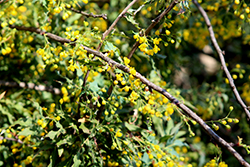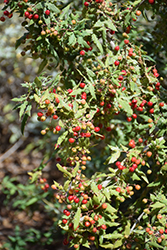It's all about ...
plants

Height: 10 feet
Spread: 12 feet
Sunlight:
![]()
![]()
Hardiness Zone: 8a
Other Names: form. Mahonia Nevinii, Odostemon nevinii
Description:
A rare California native shrub featuring upright, rigid branches covered with gray-blue leathery foliage; bright yellow flowers in clusters along the branches in late winter to spring, followed in summer by red berries; a great specimen plant or hedge
Ornamental Features
Nevin Barberry is clothed in stunning clusters of yellow flowers along the branches from late winter to mid spring. It has attractive grayish green foliage with hints of silvery blue which emerges pink in spring. The small spiny pointy compound leaves are highly ornamental and remain grayish green throughout the winter. It features an abundance of magnificent red berries from mid to late summer.
Landscape Attributes
Nevin Barberry is a dense multi-stemmed evergreen shrub with an upright spreading habit of growth. Its relatively fine texture sets it apart from other landscape plants with less refined foliage.
This shrub will require occasional maintenance and upkeep, and can be pruned at anytime. It is a good choice for attracting birds, bees and butterflies to your yard, but is not particularly attractive to deer who tend to leave it alone in favor of tastier treats. Gardeners should be aware of the following characteristic(s) that may warrant special consideration;
- Spiny
Nevin Barberry is recommended for the following landscape applications;
- Mass Planting
- Hedges/Screening
- General Garden Use
- Naturalizing And Woodland Gardens
Planting & Growing
Nevin Barberry will grow to be about 10 feet tall at maturity, with a spread of 12 feet. It has a low canopy with a typical clearance of 1 foot from the ground, and is suitable for planting under power lines. It grows at a medium rate, and under ideal conditions can be expected to live for approximately 20 years.
This shrub does best in full sun to partial shade. It is very adaptable to both dry and moist growing conditions, but will not tolerate any standing water. It is considered to be drought-tolerant, and thus makes an ideal choice for xeriscaping or the moisture-conserving landscape. It is not particular as to soil type or pH, and is able to handle environmental salt. It is somewhat tolerant of urban pollution. This species is native to parts of North America.
This plant is not reliably hardy in our region, and certain restrictions may apply; contact the store for more information.


